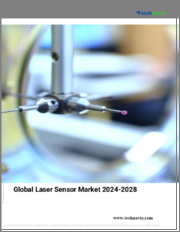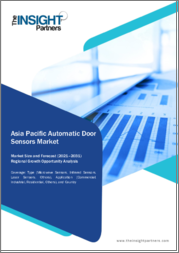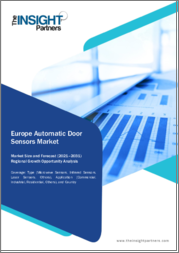
|
시장보고서
상품코드
1454057
세계의 레이저 거리 센서 시장 예측(-2030년) : 부문별 분석Laser Distance Sensor Market Forecasts to 2030 - Global Analysis By Distance (Between 2 and 10 Meters, Between 8 and 100 Meters, Between 101 and 200 Meters and Between 201 and 500 Meters), Accuracy, End User and By Geography |
||||||
세계의 레이저 거리 센서(Laser Distance Sensor) 시장은 2023년에 14억 달러였으며, 예측 기간 동안 CAGR 10.8%로 추이하며 성장 할 것으로 예상되며, 2030년에는 28억 6,000만 달러에 이를 전망입니다.
레이저 거리 센서(LDS)는 레이저 기술을 사용하여 대상 물체와 거리를 측정하는 장치입니다. 대상물을 향해 레이저 빔을 조사하고 빔이 센서에 반사되어 돌아올 때까지의 시간을 측정합니다. LDS는 로봇 공학, 산업 자동화, 네비게이션 시스템, 보안 등 다양한 분야에서 응용되고 있습니다. 고속·고정밀도로 정확한 거리 측정이 가능하기 때문에 많은 기술 용도로 이용되고 있습니다.
IoT와 스마트 디바이스 수요 증가
IoT와 스마트 디바이스가 스마트 홈, 산업용 IoT, 헬스케어, 소매 등 다양한 분야에 점점 통합됨에 따라 LDS가 제공하는 정확하고 신뢰할 수 있는 거리 측정 기능의 필요성이 가장 중요해지고 있습니다. 이러한 센서는 IoT 에코시스템에 필수적인 구성요소로, 다양한 산업에 걸쳐 다양한 스마트 용도을 가능하게 하는 중요한 거리 측정 기능을 제공함으로써 이 시장을 더욱 촉진하고 있습니다.
높은 초기 비용
LDS에서 사용되는 레이저, 검출기, 광학계, 신호 처리 회로는 복잡하고 특수한 것이 많아 제조 비용이 높습니다. 또한 이러한 기술을 혁신하고 개선하는 데 필요한 R&D 투자는 전반적인 비용의 원인이 되었습니다. 업계 표준 및 규정 준수를 위해서는 추가 시험 및 인증이 필요할 수 있으며 이 시장 규모에 방해가 되는 비용을 더욱 증가시키고 있습니다.
건설 및 인프라 개발
건설 산업에서 LDS는 측량, 수준 측량, 모니터링 등 작업에 이용되며, 건설 전문가가 구조물이 사양서대로 건설되고 품질 기준을 충족하는지 확인하는 데 도움이 됩니다. 도로, 다리, 터널 등 인프라 개발 프로젝트도 LDS 기술의 혜택을 누리고 있습니다. 또한 로봇 암이나 굴삭기 등 로봇 기계의 정확한 위치 결정을 가능하게 하고, 효율을 향상시키고, 인적 실수를 줄임으로써 시장 성장을 뒷받침하고 있습니다.
인식 부족
기능과 잠재적인 애플리케이션을 이해하려면 전문 지식과 노하우가 필요할 수 있으며 잠재적인 모든 사용자가 쉽게 액세스할 수 있는 것은 아닙니다. LDS의 장점을 소개하는 성공 사례나 사례 연구를 접할 기회가 적은 것도 인지도가 낮아지고 있습니다. 또한 낮은 인지도는 마케팅과 교육에 대한 노력이 제한적이기 때문에 시장 확대를 방해합니다.
COVID-19의 영향
COVID-19의 팬데믹은 레이저 거리 센서(LDS) 시장에 몇 가지 악영향을 미쳤습니다. 잠금, 여행 제한, 공장 폐쇄로 인한 세계적인 공급망의 혼란은 LDS 제조에 필요한 컴포넌트과 재료의 입수에 부정적인 영향을 미쳤습니다. 이는 측량, 레이아웃, 품질 관리와 같은 용도에서 LDS 수요에 직접적인 영향을 미칩니다. 또한 기업은 LDS를 필요로 하는 프로젝트를 연기하거나 취소할 수 있어 시장 수요와 판매 감소로 이어지고 있습니다.
예측 기간 동안 2-10m 부문이 최대가 될 전망
2미터에서 10미터의 부문이 가장 큰 점유율을 차지하는 것으로 추정됩니다. LDS는 레이저 기술을 채택한 전자기기로 레이저 빔을 조사하고 반사된 신호를 분석하여 거리를 정확하게 측정합니다. 2미터에서 10미터 사이의 거리 범위는 안전하고 효율적인 차량 작동을 가능하게 하는 신뢰할 수 있는 거리 정보를 제공합니다. 또한, 지정된 거리 범위 내에서 침입이나 부정한 움직임의 검출을 가능하게 하고, 부지내의 시큐리티를 강화하는 것으로, 이 부문의 확대를 뒷받침하고 있습니다.
자동차·로봇 분야는 예측기간 중 가장 높은 CAGR이 예상
자동차 및 로봇분야는 안전기준에 대한 관심이 높아지면서 보다 나은 운전체험을 요구하는 소비자의 기호에 따라 예측기간 중 가장 높은 CAGR이 예측되어 자동차분야에서 LDS 채택을 촉진하고 있습니다. LDS는 자율형 로봇의 네비게이션, 매핑, 장애물 회피를 위한 기본적인 감지 기술 역할을 합니다. 또한, 생산, 물류, 농업, 건강 관리, 서비스 로봇 등 다양한 분야에서 로봇 용도을 가능하게 하고, 이 부문 성장을 이끌고 있습니다.
최대 점유율을 차지하는 지역
아시아태평양은 급속한 산업화, 자동화의 진전, 다양한 분야의 기술 진보로 예측 기간 동안 최대 시장 점유율을 차지했습니다. 중국, 일본, 한국, 인도와 같은 국가들은 이 지역에서 LDS 시장 성장에 크게 기여하고 있습니다. 또한 LDS는 ADAS 용도에서 중요한 역할을 하고 적응형 크루즈 컨트롤, 충돌 회피, 주차 지원 등 기능을 실현하기 위해 이 지역에서 이러한 센서에 대한 수요를 촉진하고 있습니다.
CAGR이 가장 높은 지역 :
유럽은 예측 기간 동안 가장 높은 CAGR을 나타낼 것으로 예상됩니다. 유럽에서 LDS는 자동차, 항공우주, 건설, 제조 등 산업에서 널리 사용됩니다. 이 지역에는 Pantron Instruments GmbH, Ifm Electronic GmbH, Keyence Corp.와 같은 대기업이 있습니다. 또한 유럽에서는 산업 자동화와 인더스트리 4.0에 대한 이니셔티브가 중시되고 있으며, 로봇 공학, 기계 모니터링 및 품질 관리 공정에서 LDS에 대한 수요가 더욱 높아지고 있습니다.
무료 사용자 지정 오퍼링 :
이 보고서를 구독한 고객은 다음 무료 맞춤설정 옵션 중 하나를 받을 수 있습니다.
- 기업 프로파일
- 추가 시장 기업의 종합적 프로파일링(3개사까지)
- 주요 기업의 SWOT 분석(3개사까지)
- 지역 세분화
- 고객 관심 기반 주요 국가 시장 추정 및 예측·CAGR(주 : 타당성 확인에 따름)
- 경쟁 벤치마킹
- 제품 포트폴리오, 지리적 존재, 전략적 제휴에 기반한 주요 기업 벤치마킹
목차
제1장 주요 요약
제2장 서문
- 개요
- 이해관계자
- 조사 범위
- 조사 방법
- 데이터 마이닝
- 데이터 분석
- 데이터 검증
- 조사 접근
- 조사 소스
- 1차 조사 소스
- 2차 조사 소스
- 전제조건
제3장 시장 동향 분석
- 성장 촉진요인
- 억제요인
- 기회
- 위협
- 최종 사용자 분석
- 신흥 시장
- COVID-19의 영향
제4장 Porter's Five Forces 분석
- 공급기업의 협상력
- 구매자의 협상력
- 대체품의 위협
- 신규 진입업자의 위협
- 경쟁 기업간 경쟁 관계
제5장 세계의 레이저 거리 센서 시장 : 거리별
- 2-10미터
- 8-100미터
- 101-200미터
- 201-500미터
제6장 세계의 레이저 거리 센서 시장 : 정밀도별
- 2 시그마, 1mm
- 2 시그마, 3mm
- 2 시그마, 5mm
제7장 세계의 레이저 거리 센서 시장 : 최종 사용자별
- 건설
- 자동차와 로봇 공학
- 제조업
- 항공우주 및 방위
- 지리공간산업
- 기타 최종 사용자
제8장 세계의 레이저 거리 센서 시장 : 지역별
- 북미
- 미국
- 캐나다
- 멕시코
- 유럽
- 독일
- 영국
- 이탈리아
- 프랑스
- 스페인
- 기타 유럽
- 아시아태평양
- 일본
- 중국
- 인도
- 호주
- 뉴질랜드
- 한국
- 기타 아시아태평양
- 남미
- 아르헨티나
- 브라질
- 칠레
- 기타 남미
- 중동 및 아프리카
- 사우디아라비아
- 아랍에미리트(UAE)
- 카타르
- 남아프리카
- 기타 중동 및 아프리카
제9장 주요 발전
- 계약, 파트너십, 협업, 합작 투자
- 인수와 합병
- 신제품 발매
- 사업 확대
- 기타 주요 전략
제10장 기업 프로파일
- ifm Electronic GmbH
- Keyence Corp
- Sick AG
- Pepperl Fuchs SE
- Baumer Holding AG
- Banner Engineering Corp
- Leuze electronic GmbH & Co KG
- Wenglor Sensoric Electronic Devices GmbH
- Jenoptik AG
- Pantron Instruments GmbH
According to Stratistics MRC, the Global Laser Distance Sensor Market is accounted for $1.40 billion in 2023 and is expected to reach $2.86 billion by 2030 growing at a CAGR of 10.8% during the forecast period. A Laser Distance Sensor (LDS) is a device that measures the distance between itself and a target object using laser technology. It emits a laser beam towards the object and measures the time it takes for the beam to reflect back to the sensor. LDS finds applications in various fields including robotics, industrial automation, navigation systems, and security. It offers precise distance measurements with high speed and accuracy, making it valuable for numerous technological applications.
Market Dynamics:
Driver:
Rising demand for IoT and smart devices
As IoT and smart devices become increasingly integrated into various sectors, such as smart homes, industrial IoT, healthcare, and retail, the need for accurate and reliable distance measurement capabilities provided by LDS becomes paramount. These sensors are integral components of IoT ecosystems, providing crucial distance measurement capabilities that enable a wide range of smart applications across various industries, thereby propelling this market further.
Restraint:
High initial costs
The lasers, detectors, optics, and signal processing circuitry used in LDSs are often complex and specialized, resulting in higher production costs. Additionally, the research and development investments required to innovate and improve these technologies contribute to the overall cost. Compliance with industry standards and regulations may necessitate additional testing and certification, further increasing the expenses that are hampering this market size.
Opportunity:
Construction and infrastructure development
In the construction industry, LDSs are utilized for tasks such as surveying, leveling, and monitoring that help construction professionals ensure that structures are built according to specifications and meet quality standards. Infrastructure development projects, such as roads, bridges, and tunnels, also benefit from LDS technology. Furthermore, they enable the precise positioning of robotic machinery, such as robotic arms and excavators, improving efficiency and reducing human errors, which is boosting market growth.
Threat:
Lack of awareness
Understanding their functionality and potential applications may require specialized knowledge or expertise, which may not be readily accessible to all potential users. Lack of exposure to success stories and case studies showcasing the benefits of LDSs further contributes to the limited awareness. In addition, the lack of awareness can be attributed to limited marketing and educational efforts, which are hindering this market expansion.
Covid-19 Impact
The COVID-19 pandemic has brought about several negative impacts on the laser distance sensor (LDS) market. The global supply chain disruptions caused by lockdowns, travel restrictions, and factory closures have adversely affected the availability of components and materials necessary for manufacturing LDS. This has directly affected the demand for LDS in applications such as surveying, layout, and quality control. Moreover, businesses may postpone or cancel projects that require LDS, leading to decreased demand and sales in the market.
The between 2 and 10 meters segment is expected to be the largest during the forecast period
The between 2 and 10 meters segment is estimated to hold the largest share. LDSs are electronic devices that employ laser technology to precisely measure distances by emitting laser beams and analyzing the reflected signals. Within the 2 to 10-meter distance range, they provide reliable distance information to enable safe and efficient vehicle operations. Additionally, they enable the detection of intrusions or unauthorized movements within a specified distance range, enhancing the security of premises and thereby boosting this segment's expansion.
The automotive and robotics segment is expected to have the highest CAGR during the forecast period
The automotive and robotics segment is anticipated to have highest CAGR during the forecast period due to a growing focus on safety standards and consumer preferences for enhanced driving experiences, which propels the adoption of LDS in the automotive sector. LDS serves as a fundamental sensing technology for navigation, mapping, and obstacle avoidance in autonomous robots. Moreover, this enables robotics applications in diverse fields such as manufacturing, logistics, agriculture, healthcare, and service robotics, which are driving this segment's growth.
Region with largest share:
Asia Pacific commanded the largest market share during the extrapolated period owing to rapid industrialization, increasing automation, and technological advancements across various sectors. Countries like China, Japan, South Korea, and India are key contributors to the growth of the LDS market in the region. Moreover, LDS play a crucial role in ADAS applications, enabling features like adaptive cruise control, collision avoidance, and parking assistance, thus driving the demand for these sensors in the region.
Region with highest CAGR:
Europe is expected to witness highest CAGR over the projection period. In Europe, LDS finds extensive applications across industries such as automotive, aerospace, construction, and manufacturing. This region is home to some of the major players, such as Pantron Instruments GmbH, Ifm Electronic GmbH, and Keyence Corp. Furthermore, Europe's emphasis on industrial automation and Industry 4.0 initiatives further drives the demand for LDS in robotics, machinery monitoring, and quality control processes.
Key players in the market
Some of the key players in the Laser Distance Sensor Market include ifm Electronic GmbH, Keyence Corp, Sick AG, Pepperl+Fuchs SE, Baumer Holding AG, Banner Engineering Corp, Leuze electronic GmbH & Co KG, Wenglor Sensoric Electronic Devices GmbH, Jenoptik AG and Pantron Instruments GmbH.
Key Developments:
In Febuary 2023, Patron announced new AI art generator to craft the margarita of your dreams.
In January 2022, Patron has teamed up with BlockBar.com, the world's first direct to consumer NFT marketplace for wine and spirits, to launch it's first-ever NFT, unlocking a bottle of the limited-edition PATRON Chairman's Reserve.
In May 2021, Keyence has announced an enhancement to its dimensional measurement system, which it says now, delivers greater speed, accuracy, and ease of use.
Distances Covered:
- Between 2 and 10 Meters
- Between 8 and 100 Meters
- Between 101 and 200 Meters
- Between 201 and 500 Meters
Accuracy Covered:
- 1mm at 2 Sigma
- 3mm with 2 Sigma
- 5mm at 2 Sigma
End Users Covered:
- Construction
- Automotive and Robotics
- Manufacturing
- Aerospace and Defence
- Geospatial Industry
- Other End Users
Regions Covered:
- North America
- US
- Canada
- Mexico
- Europe
- Germany
- UK
- Italy
- France
- Spain
- Rest of Europe
- Asia Pacific
- Japan
- China
- India
- Australia
- New Zealand
- South Korea
- Rest of Asia Pacific
- South America
- Argentina
- Brazil
- Chile
- Rest of South America
- Middle East & Africa
- Saudi Arabia
- UAE
- Qatar
- South Africa
- Rest of Middle East & Africa
What our report offers:
- Market share assessments for the regional and country-level segments
- Strategic recommendations for the new entrants
- Covers Market data for the years 2021, 2022, 2023, 2026, and 2030
- Market Trends (Drivers, Constraints, Opportunities, Threats, Challenges, Investment Opportunities, and recommendations)
- Strategic recommendations in key business segments based on the market estimations
- Competitive landscaping mapping the key common trends
- Company profiling with detailed strategies, financials, and recent developments
- Supply chain trends mapping the latest technological advancements
Free Customization Offerings:
All the customers of this report will be entitled to receive one of the following free customization options:
- Company Profiling
- Comprehensive profiling of additional market players (up to 3)
- SWOT Analysis of key players (up to 3)
- Regional Segmentation
- Market estimations, Forecasts and CAGR of any prominent country as per the client's interest (Note: Depends on feasibility check)
- Competitive Benchmarking
- Benchmarking of key players based on product portfolio, geographical presence, and strategic alliances
Table of Contents
1 Executive Summary
2 Preface
- 2.1 Abstract
- 2.2 Stake Holders
- 2.3 Research Scope
- 2.4 Research Methodology
- 2.4.1 Data Mining
- 2.4.2 Data Analysis
- 2.4.3 Data Validation
- 2.4.4 Research Approach
- 2.5 Research Sources
- 2.5.1 Primary Research Sources
- 2.5.2 Secondary Research Sources
- 2.5.3 Assumptions
3 Market Trend Analysis
- 3.1 Introduction
- 3.2 Drivers
- 3.3 Restraints
- 3.4 Opportunities
- 3.5 Threats
- 3.6 End User Analysis
- 3.7 Emerging Markets
- 3.8 Impact of Covid-19
4 Porters Five Force Analysis
- 4.1 Bargaining power of suppliers
- 4.2 Bargaining power of buyers
- 4.3 Threat of substitutes
- 4.4 Threat of new entrants
- 4.5 Competitive rivalry
5 Global Laser Distance Sensor Market, By Distance
- 5.1 Introduction
- 5.2 Between 2 and 10 Meters
- 5.3 Between 8 and 100 Meters
- 5.4 Between 101 and 200 Meters
- 5.5 Between 201 and 500 Meters
6 Global Laser Distance Sensor Market, By Accuracy
- 6.1 Introduction
- 6.2 1mm at 2 Sigma
- 6.3 3mm with 2 Sigma
- 6.4 5mm at 2 Sigma
7 Global Laser Distance Sensor Market, By End User
- 7.1 Introduction
- 7.2 Construction
- 7.3 Automotive and Robotics
- 7.4 Manufacturing
- 7.5 Aerospace and Defence
- 7.6 Geospatial Industry
- 7.7 Other End Users
8 Global Laser Distance Sensor Market, By Geography
- 8.1 Introduction
- 8.2 North America
- 8.2.1 US
- 8.2.2 Canada
- 8.2.3 Mexico
- 8.3 Europe
- 8.3.1 Germany
- 8.3.2 UK
- 8.3.3 Italy
- 8.3.4 France
- 8.3.5 Spain
- 8.3.6 Rest of Europe
- 8.4 Asia Pacific
- 8.4.1 Japan
- 8.4.2 China
- 8.4.3 India
- 8.4.4 Australia
- 8.4.5 New Zealand
- 8.4.6 South Korea
- 8.4.7 Rest of Asia Pacific
- 8.5 South America
- 8.5.1 Argentina
- 8.5.2 Brazil
- 8.5.3 Chile
- 8.5.4 Rest of South America
- 8.6 Middle East & Africa
- 8.6.1 Saudi Arabia
- 8.6.2 UAE
- 8.6.3 Qatar
- 8.6.4 South Africa
- 8.6.5 Rest of Middle East & Africa
9 Key Developments
- 9.1 Agreements, Partnerships, Collaborations and Joint Ventures
- 9.2 Acquisitions & Mergers
- 9.3 New Product Launch
- 9.4 Expansions
- 9.5 Other Key Strategies
10 Company Profiling
- 10.1 ifm Electronic GmbH
- 10.2 Keyence Corp
- 10.3 Sick AG
- 10.4 Pepperl+Fuchs SE
- 10.5 Baumer Holding AG
- 10.6 Banner Engineering Corp
- 10.7 Leuze electronic GmbH & Co KG
- 10.8 Wenglor Sensoric Electronic Devices GmbH
- 10.9 Jenoptik AG
- 10.10 Pantron Instruments GmbH



















